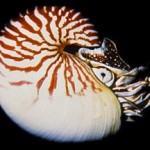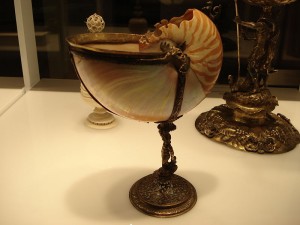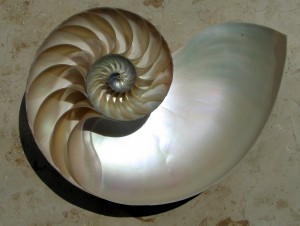 I have learned that I am not a continuous learner. I learn in sometimes dazzling bursts. But then I go through a phase of consolidation and integration. It’s as if I need some time to rest, refresh, renew, and maybe even reshape my view of the world, before blazing into another flaming glory of learning.
I have learned that I am not a continuous learner. I learn in sometimes dazzling bursts. But then I go through a phase of consolidation and integration. It’s as if I need some time to rest, refresh, renew, and maybe even reshape my view of the world, before blazing into another flaming glory of learning.
Excuse the lapse into somewhat poetic language, but the imagery works really well for me. Another image that captures my sense of non-continuous learning is the chambered nautilus (nautilus pompilius). Before I get into that imagery, I’d like to delve a bit deeper into the backstory of the nautilus.
 The nautilus is a mollusk, distantly related to clams, oysters and mussels, and a cephalopod, the class of the animal kingdom that includes the squid and the octopus – all creatures whose heads are attached to their feet. The nautilus has been around for over 400 million years, and is considered by many to be a living fossil, having changed very little over the vast lifetime of the species. (Perhaps that label explains some of my personal attachment to the nautilus.)
The nautilus is a mollusk, distantly related to clams, oysters and mussels, and a cephalopod, the class of the animal kingdom that includes the squid and the octopus – all creatures whose heads are attached to their feet. The nautilus has been around for over 400 million years, and is considered by many to be a living fossil, having changed very little over the vast lifetime of the species. (Perhaps that label explains some of my personal attachment to the nautilus.)
Besides being really old, the nautilus is a bit odd. (Another reason for me to like the nautilus.) It lives in very deep water, coming up to shallow water to feed on coral reefs at night It has eyes with no lenses, so its vision system operates like a pinhole camera, severely limiting it’s eyesight. The nautilus compensates by using its sense of smell to search out food – it eats only about once a month, so who’s to say how good it’s olfactory system has to be. It also sniffs out a mate when it is ready to propagate. Although, like other cephalopods the nautilus uses jet propulsion to attain speeds of up to two knots, it’s the only cephalopod with a shell. And it’s that SHELL that is the real story.
 The beautiful shell of the chambered nautilus is counter shaded to help avoid predators, light-colored on the bottom and dark-colored on the top, so when seen from above it blends with the darkness of the sea bottom, and when seen from below it blends with the light from above. The nautilus shell, when bisected, presents a nearly perfect equiangular or logarithmic spiral. The beauty of the shell has been recognized for centuries. As far back as the Renaissance, goldsmiths created elaborate ornamental drinking cups from nautilus shells, and ornamental nautilus shells found their way into many private, natural history collections, commonly known as cabinets of curiosities.
The beautiful shell of the chambered nautilus is counter shaded to help avoid predators, light-colored on the bottom and dark-colored on the top, so when seen from above it blends with the darkness of the sea bottom, and when seen from below it blends with the light from above. The nautilus shell, when bisected, presents a nearly perfect equiangular or logarithmic spiral. The beauty of the shell has been recognized for centuries. As far back as the Renaissance, goldsmiths created elaborate ornamental drinking cups from nautilus shells, and ornamental nautilus shells found their way into many private, natural history collections, commonly known as cabinets of curiosities.
 The nautilus shell is divided into chambers. Scientists aren’t exactly certain, but believe that newly hatched nautili start their lives with four to seven chambers. Each chamber is individually sealed and filled with gas, providing buoyancy. The nautilus can regulate its density by injecting water into or draining water out of the chambers through a series of tubes, allowing it to dive or ascend through the ocean depths. It was certainly this feature of nautilus physiology that inspired Jules Verne, when writing his classic novel, Twenty Thousand Leagues Under the Sea, to name Captain Nemo’s sub-marine vessel the Nautilus.
The nautilus shell is divided into chambers. Scientists aren’t exactly certain, but believe that newly hatched nautili start their lives with four to seven chambers. Each chamber is individually sealed and filled with gas, providing buoyancy. The nautilus can regulate its density by injecting water into or draining water out of the chambers through a series of tubes, allowing it to dive or ascend through the ocean depths. It was certainly this feature of nautilus physiology that inspired Jules Verne, when writing his classic novel, Twenty Thousand Leagues Under the Sea, to name Captain Nemo’s sub-marine vessel the Nautilus.
As it grows, the nautilus will add new chambers to it’s shell, each chamber larger than the last, allowing the opening of the shell to grow continually larger to accommodate the ever larger nautilus living within. This is what I find compelling about the chambered nautilus as an image to represent my growth as a learner.
It helps me understand a bit of my own behavior, in particular my periodic withdrawal, while I try to enlarge that shell, so that when I re-emerge, there’s more room than there was before. I hope that’s what I’m doing. And maybe someday I won’t need that shell, because I’ll understand what it is I fear; why I need the protective cover. When I can face down those fears, I’ll be able to give up the shell.
Alas, I’m not the first great thinker to make this allusion. Oliver Wendell Holmes, a physician, professor and author, [not to be confused with his son, Supreme Court Justice Oliver Wendell Holmes, Jr.] who was considered by his peers to be one of the finest writers of the 19th century, penned the poem, The Chambered Nautilus, more than 150 years ago. In the poem, Holmes compared the nautilus and its shell to human intellectual growth. He believed that humans can eventually outgrow their protective shells and discard them completely. I hope that Holmes was right about that, when he wrote so beautifully in the final stanza of his poem
“Build thee more stately mansions, O my soul,
As the swift seasons roll!
Leave thy low-vaulted past!
Let each new temple, nobler than the last,
Shut thee from heaven with a dome more vast,
Till thou at length art free,
Leaving thine outgrown shell by life’s unresting sea!”
You are damn good as blogger. I knew that, but am still impressed. Mad even. You make this look so easy.
Wow. Thanks for the compliment. I hope my writing can keep you interested. In the meantime, tell your friends.